|
FOREST HEALTH LEGISLATION PROGRESSINGOCTOBER 14 -- SUNRIVER, OR: A Congressional forest health bill that would reduce project appeals and increase timber harvest on federal lands could become law within weeks. But the Healthy Forest Restoration Act needs to be reworked, according to Rep. Greg Walden of Oregon, to eliminate provisions added by the Senate that would expand public participation in the appeals process.
The Bend Bulletin reported that the Senate provisions were added by Sen. Ron Wyden of Oregon, and include measures to protect old growth. In Sunriver Monday for the annual Oregon Forest Industries Council meeting, Walden said there is too much ammunition under current federal forest rules for opponents to derail logging and thinning projects. He said the Senate provisions were added as part of a compromise package, and they could undermine key pieces of the legislation.
Walden, who took a tour of what's left of the B&B Complex, said the nation's forests have reached a critical point. He said the 2002 Biscuit Fire burned about 4 billion board feet of timber -- that's more wood than the total wood products output of all Oregon forests in the same year.
He said the appeals process has been hijacked by eco-terrorists whose only answers are "do nothing and stop everything."
Steve Mealey was a forest supervisor on the Boise and Shoshone national forests before taking a job as an ecologist with Boise Cascade. "The gridlock is very real," said Mealey. "The Forest Service tries to do the right thing in many cases. And they get sued for doing those things and then they get sued for doing nothing."
Also on Monday, Agriculture Undersecretary Mark Rey attended a forum at the University of Washington, drawing a crowd of protesters. "Don't Bush whack our forests," said stickers worn by several protesters.
"They're taking the 'public' out of public lands," said Patti Goldman of Earthjustice.
During the forum, according to an AP report, Professor Jerry Franklin called for an administration pledge to put old-growth forests and roadless areas off limits to logging. He said that would remove 90 percent of the environmental opposition to federal forest practices.
Rey, though, said the issues aren't that simple. There are 160 definitions of "old growth," he said. Rey, Franklin, and several other UW forestry professors who spoke agreed that reducing fuels on federal forest lands is a top priority.

STAHL'S FSEEE GROUP SUES USFS OVER FIREFIGHTINGOCTOBER 13 -- EUGENE, OR: The Eugene-based group called Forest Service Employees for Environmental Ethics (FSEEE) will file suit against the Forest Service tomorrow, demanding that the agency formally and publicly evaluate the environmental and social effects of wildland firefighting.
"Too many firefighters die each year in a fruitless and self-defeating war against fire," said Andy Stahl, executive director. The complaint, according to the Missoulian, will be filed in U.S. District Court in Missoula -- not because of previous enviro-friendly rulings by U.S. District Judge Don Molloy, but because, Stahl said, "Missoula is the nerve center of a huge fire industrial complex."
"The Forest Service has never, not once in its history, weighed the pros and cons of firefighting," said Marc Fink, the Western Environmental Law Center attorney representing FSEEE in the lawsuit. Stahl said FSEE's board of directors decided to expand its mission to include "ending the war on fire" about two years ago, after four firefighters were killed on the Thirtymile Fire.
"We can't think of a more appropriate organization to come to the defense of wildland firefighters or to hold our agency accountable for the unwarranted risk it places on its employees," Stahl said. "Who better to question this unjustified loss of life and squandering of almost a billion dollars a year?"
Firefighters will undoubtedly appreciate FSEEE's actions on their behalf. Despite its name, only a very small percentage of FSEEE's membership actually are or ever were Forest Service employees.
The lawsuit also challenges the use of retardant in aerial firefighting. It says the Forest Service has never prepared an environmental impact statement on its use, nor has it formally considered alternatives. "It is time to evaluate which fires should be fought and which should not be fought," said Stahl. "And we should simply stop fighting particular classes of fires -- for instance, those that burn in the early spring or late fall, when conditions are conducive to low-intensity fire."

TANKER PILOTS IDENTIFIEDOCTOBER 10 -- SAN BERNARDINO, CA:
Pilot Carl Dolbeare, 54, and his Co-Pilot John Attardo, 51, were killed Friday when the airtanker they were flying from Prescott, Arizona, to San Bernardino crashed on the San Bernardino National Forest just minutes shy of their destination. They departed Prescott just before 10 a.m. and went down north of the Seven Oaks Dam at 11:35 a.m.
Tanker 99, owned by Minden Air in Nevada, was on the Alamogordo/Missoula contract this year. It was in September assigned to San Bernardino. The crew returned to Arizona late in September to work a fire at the Grand Canyon, and last week were returning from Prescott to San Bernardino.

Carl Dolbeare, who lived in Arizona, was in the tanker business for over 25 years, and had been with Minden Air since 1999. He held type ratings in B-17, B-34, C-119, DC-4 and L-P2V aircraft. Attardo, originally from Boston, lived in Fort Collins, Colorado. He was airline transport pilot (ATP) rated.
The NTSB preliminary report indicates that visual instrument meteorological conditions prevailed on Friday at March Air Force Base, which was the nearest official reporting station. Instrument meteorological conditions prevailed at the accident site, and a company visual flight rules (VFR) flight plan had been filed.
One of two observers at a forest lookout tower north of the accident site holds a
commercial pilot certificate with an instrument rating. They reported later that they saw a cloud layer as far to the south as they could see, and they estimated the cloud tops at around 5,000 feet. Visibility on the ground at San Bernardino shortly after the incident was 1-2 miles, but the marine layer through which the tanker was attempting to descend was reportedly more than 1,000 feet thick.
The lookouts said they watched T-99 flying from the south up a canyon near the edge of the clouds; they said the airtanker was at a lower altitude than the 7,900-foot elevation of the lookout. They said the airtanker made a steep 180-degree turn, leveled out, and then entered the cloud layer. A couple minutes later the top of the cloud layer bulged, and the lookouts called in to report a possible tanker crash.
Because Dolbeare and Attardo were overdue at San Bernardino and could not be reached by radio, a search team was sent out. They located the crash site, on a steep hillside at about 3,400 feet, at 1 p.m.
A memorial fund has been established, and condolences may be sent to Tina Attardo and Gwen Bean at Minden Air Corp., 2311 P-51 Court, Minden, Nevada 89423.

TANKER 99 DOWNOCTOBER 03 -- SAN BERNARDINO, CA: Minden Air's Tanker 99 went down today on the San Bernardino National Forest, and according to news reports, both pilots were killed. The airtanker was on a ferry flight from Prescott to San Bernardino when it crashed near Lake Arrowhead.
NTSB investigators are en route. A so-far-unidentified news helicopter was seen over the crash area this afternoon before the Temporary Flight Restriction (TFR) was officially approved. News reports are online here:
Minden Air personnel are en route to southern California, and updates will be posted here as details are confirmed.

POST-MORTEM ALCOHOL RESULTS CAN BE MISLEADINGOCTOBER 03 -- ROSEBURG, OR: A number of news reports (and subsequent discussion on message boards) have been posted in the last couple days regarding the blood-alcohol results of toxicology reports following the fatal crash on Highway 20 in eastern Oregon that killed eight contract firefighters near Vale, Oregon.
Those reports, however, should not be considered "evidence" that the driver or passengers were drinking prior to the crash. A convenience store video does show crewmembers purchasing beer. And surviving crewmembers corroborate that, but they also say that the beer was in a cooler on top of the van racks.
This has been an issue over the last few years with the survivors of pilots killed in airtanker crashes, and the subject is on the agenda for this year's annual meeting of the Associated Airtanker Pilots.
It is not unusual for alcohol to be detected during toxicological testing of aviation accident victims. Post-mortem ethanol production, according to aircraft crash investigation reports by the Transportation Safety Board of Canada, is the result of bacterial action after death. The presence of ethanol depends on various factors, such as the condition of the tested specimen, the environmental conditions to which the tissues were exposed, and the time duration before the specimen was recovered. To confirm the conditions for this phenomenon, testing was conducted on specimens from individuals who would not have been expected to have ingested alcohol because of age or cultural background. Of the six specimens tested, five tested positive for ethanol.
Microorganisms in decomposing bodies frequently produce alcohol in amounts equivalent to intoxication, according to Gary Kunsman, chief toxicologist with the Bexar County (Texas) medical examiner's office. Kunsman has been involved with cases where the post-mortem indication of a high blood-alcohol content was an issue.
"Post-mortem alcohol production is a very odd thing," said Kunsman. "It doesn't occur in all bodies, and it doesn't occur at the same rate in bodies, even under the same conditions."
Microorganisms in the body, including yeast, can produce alcohol in body tissues after death. Kunsman, who worked for the armed forces medical examiner in Washington, DC, said post-mortem alcohol levels were often seen in military pilots killed in aircraft crashes. "You know the pilot's not drinking," explained Kunsman. "He crashes, it takes a week or two to locate the body, get him back, autopsy him. And we would find alcohol levels of 0.2 or 0.3."
Bacteria in some areas of the body escape and can generate ethanol in the blood, brain, liver, and other tissues within a few hours of death. In his paper "Pitfalls in Forensic Toxicology," T. Richardson of the Toxicology Lab at England's Manchester Royal Infirmary said that concentrations can reach 1500 mg per liter within a few days, and physical disruption of the body can enhance post-mortem alcohol production. Post-mortem urine and vitreous fluid, however, are largely free of this effect.
Though the possession of alcohol in the van violated the agreement between the contract firefighters' employer and the Oregon Department of Forestry, the post-mortem indications of blood-alcohol don't yet indicate intoxication on the part of the driver or other firefighters.

FIREFIGHTERS HONORED AT NATIONAL CEREMONYOCTOBER 03 -- EMMITSBURG, MD: Oregon firefighters who died in a van crash on their way to a Colorado fire last year will be among more than 100 honored Sunday at the National Fallen Firefighters Memorial Service in Emmitsburg.
Homeland Security Secretary Tom Ridge will be the keynote speaker at the event, according to an AP story. Attendees will pay tribute to 99 firefighters who died in the line of duty in 2002, plus six who died in previous years.
 "When a firefighter loses his or her life in the line of duty, it is not only a loss for the family," said David Paulison with the U.S. Fire Administration, "but a loss for the community and the nation's family of firefighters." "When a firefighter loses his or her life in the line of duty, it is not only a loss for the family," said David Paulison with the U.S. Fire Administration, "but a loss for the community and the nation's family of firefighters."
The honor roll lists firefighters from 36 states.
A candlelight service will be held at the Basilica of the National Shrine of St. Elizabeth Ann Seton on Saturday, and shuttle service is available for the Sunday tribute memorial, which begins at 10 a.m. at the national monument to all fallen firefighters.
The National Fallen Firefighters Foundation will broadcast the candlelight service and the memorial service live from the National Fire Academy campus. To view the services, contact your local cable provider and ask them to broadcast the events on one of the public access channels. The satellite coordinates for the broadcast are available online at http://216.213.151.12/Index1.asp?id=6646
The Foundation has committed to pay for the travel, lodging, and meals of the immediate next-of-kin of each 2002 fallen firefighter. You can make a tax-deductible donation online or send a check to by sending a check to the NFFF at P.O. Drawer 498 Emmitsburg Maryland 21727. For more information, email [email protected]

LIGHTNING KILLS UTAH MAN AND STARTS FIREOCTOBER 02 -- SALT LAKE CITY, UTAH: A lightning storm late yesterday killed a 64-year-old man in a boat on Strawberry Reservoir while he was trying to load the boat onto a trailer. He was pronounced dead at the scene; his name has not been released.
About an hour before that, lightning ignited a fire in the Israel Canyon area on the northeast side of Lake Mountain. About 75 acres were burned, according to Teresa Rigby with the BLM. She said 20 firefighters were pulled from the fire because of fierce winds. The fire is burning just north of where the Jacob Ranch Fire burned 120 acres in July.

MONTANA FIRE COSTS THIS YEAR
TWICE WHAT THEY WERE IN 2000OCTOBER 02 -- HELENA, MT: The state of Montana is faced with a fire bill this year of $27 million, nearly twice the $15 million total of the devastating 2000 fire season. About 167,000 acres burned in 2000, compared with 200,000 this year.
State Forester Bob Harrington said this year's bill could run $30 million, according to a report by the Missoulian, and the state's Senate Minority Leader Jon Tester has asked for an audit of the season's costs.
Harrington said that FEMA has changed the way it helps states pay for wildfires. Three years ago, FEMA declared the entire state a disaster area early in the season. After that declaration, the federal government paid the entire cost for Montana wildfires. But he says statewide declarations are rare now. This year, FEMA never did declare the entire state a disaster; only individual fires were declared disaster areas. The agency was even reluctant to declare entire counties disasters, and would do so only if several FEMA-paid fires were burning in that county.
Even with that designation, FEMA pays only 75 percent of the firefighting costs, leaving the state to make up the rest.
"That's a big impact in out-of-pocket costs," Harrington said.
He said FEMA's help was still substantial -- without it, Montana would be facing a $63 million firefighting bill.
Tester said he wanted to know more about where the firefighting money went and why, adding that the reduction in federal help may change the way the state legislature budgets for fire. Senate President Bob Keenan agreed, saying the state needs to determine how FEMA will pay for fires in the future, and then the legislature could consider a contingency fund for firefighting.

FIRE NEAR CAJON PASS THREATENS RANCHESOCTOBER 02 -- LOS ANGELES, CA: An 800-acre fire burning in chaparral in the San Gabriel Mountains south of the Cajon Pass was spreading rapidly yesterday. As fire units arrived, the fire made runs up the steep slopes. The steep and rugged terrain, along with with erratic winds and heavy smoke, were a challenge for crews.
NBC4-TV reported that the fire started yesterday afternoon in Lytle Creek Canyon and is about five miles southeast of Wrightwood.
The Lytle Fire was about 20 percent contained this morning, with ranches threatened and local road closures in effect. Domanski's Type 2 team is managing the fire.
One firefighter suffered a minor knee injury.
More than 680 firefighters are on the fire, along with helicopters, airtankers, and a "SuperScooper." This is not, however, one of L.A. County's Canadian CL-415 scoopers -- two of which arrived on Monday and were put into service yesterday, according to the L.A. County Fire Department.
"The fire was pretty calm overnight," said Robin Renteria with the San Bernardino National Forest. She said temperatures are forecast today in the high 80s with winds of 10 to 20 mph. The San Jose Mercury-News reported that five homes and five outbuildings were threatened by the fire, which is burning in 6-foot-high chaparral.

ROSEBURG FIREFIGHTERS WHO DIED IN CRASH
BOUGHT BEER IN VALEOCTOBER 02 -- ROSEBURG, OR: The eight contract firefighters who died in a van crash on their way home from an Idaho fire had purchased alcohol prior to the crash, according to their boss Bob Krueger, president of First Strike Environmental. Malheur County authorities, according to an AP report, told Krueger that a videotape from a convenience store in Vale showed crewmembers purchasing beer.
Surviving crewmembers confirmed the purchase, but they said the beer was put in a cooler on a rack on top of the van. Toxicology reports on the driver and seven passengers have not been released, and law enforcement officers have not said whether any of the firefighters had alcohol in their systems. The eight firefighters were killed in August when the van they were driving collided with a truck on Highway 20 about 16 miles west of Vale.
The presence of alcohol with the crew violated the contract between First Strike and the Oregon Department of Forestry.

TEHAMA COUNTY OPPOSES RURAL FIRE TAXOCTOBER 02 -- RED BLUFF, CA: The Tehama County Board of Supervisors is urging the governor to veto California's Senate Bill 1049, which would add an annual tax of $35 to rural property owners' tax bills to boost funding for fire protection.
"The Legislature is picking on a small group of people instead of doing what will benefit all the people," said Supervisor Charles Willard.
The Red Bluff Daily News reported that counties would be required to increase the fee to cover their cost of the state-mandated fee collection process.
The board said all Californians benefit from CDF's fire protection services, not just property owners in the state responsibility areas. Provisions in SB 1049 would assess the same fire-protection fee regardless of the size of the property. The text of the bill is online at wildfirenews.com/sb1049

CREWS MAKING PROGRESS ON SPANISH FIREOCTOBER 02 -- ALDER SPRINGS, CA: The 4,610-acre Spanish Fire west of Alder Springs is estimated at 45 percent containment this morning. The fire was active in a few areas yesterday, with some torching across the interior of the fire.
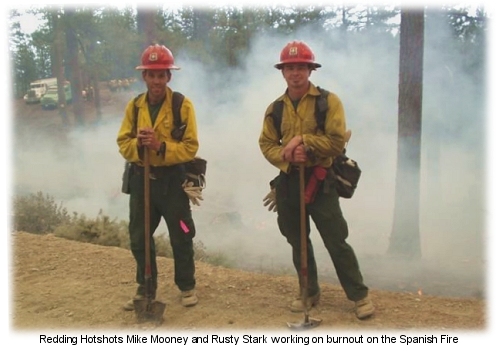
There are 43 engines and 45 crews assigned, with nine helicopters, nine dozers, and 23 water tenders. Walker's Type 2 team is on the fire, which was reported Sunday near Boardtree Campground on the Mendocino National Forest.

RURAL HOMEOWNERS IN CALIFORNIA MAY
BE TAXED FOR FIRE PROTECTIONOCTOBER 01 -- SACRAMENTO, CA: State legislators have quietly passed a $77 million bill that would charge thousands of rural property owners a first-ever state fee for fire protection.
The bill is expected to offset about $50 million in cuts absorbed this year by the California Department of Forestry and Fire Protection. According to a report by the Santa Rosa Press-Democrat, the bill would raise $52.5 million annually from a $35-per-parcel fee on 1.5 million properties statewide.
Karen Terrill with CDF said similar proposals in the past never made it out of the Legislature. "These are extraordinary times," she said. The fees would account for 12 percent of the CDF fire protection budget.
Supporters of the bill see it as a way to get residents in the wildland/urban interface to pay their fair share for fire protection. But opponents say that state law requires voter approval for new taxes.
Provisions in SB 1049 would assess the same fire-protection fee regardless of the size of the property. Some have suggested adjusting the fees next year to reflect parcel size. If approved, rural residents will see a $70 charge on next year's tax bill for this year's and next year's taxes. Subsequent bills would be $35 per year.
The text of the bill is online at wildfirenews.com/sb1049

NEW MEXICO FIRES ALLOWED TO BURNSEPTEMBER 30 -- SILVER CITY, NM: Two wildfires burning near Silver City haven't yet required suppression actions, and they probably won't. The Chester Fire about 16 miles southwest of Silver City was ignited by lightning on September 3, and firefighters are using a confinement strategy on the fire.
"Confinement strategy can only be applied to fires that have started naturally - by lightning - when weather and fuel conditions are right," said district FMO Toy Sepulveda. He explained that the fires meander in and out of available ground fuels, reducing hazardous fuels and allowing fire to resume its natural role.
The Chester Fire has grown from less than 10 acres last week to more than 100 acres this week, according to a report by the Silver City Daily Press. About 50 percent of the size is attributed to burnout and blacklining done by the Silver City Hotshots.
"The burnouts and black-lining operations ensure that the fire does not go beyond its boundary," said Loretta Ray, fire information officer.
The Goosechase Fire near Little Cherry Creek was ignited by lightning on August 28. It grew from four acres last week to about 32 acres yesterday. It's also under a confinement strategy. Ray said both fires will probably burn until rain or other precipitation ends the fire season.

SMOKE FROM SPANISH FIRE DRIFTS
NORTH TO SISKIYOU COUNTYSEPTEMBER 30 -- ALDER SPRINGS, CA: The Spanish Fire on the Mendocino yesterday made some serious runs with spotting and active fire behavior in the afternoon, including torching and crowning. Walker's Type 2 team expects that the fire will continue to spread up-canyon to the north and northeast, but cooler temperatures and increased humidity may reduce fire behavior. Winds at Alder Springs have been light today, 5 to 10 mph, with temperatures in the low 70s and RH near 30 percent.
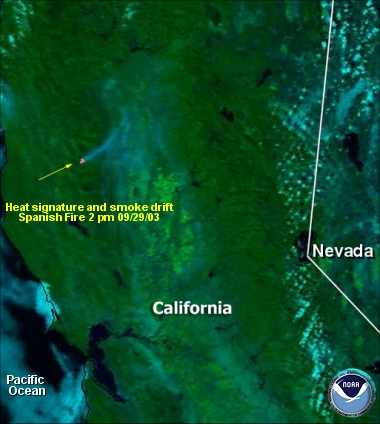 Siskiyou County Air Pollution Control Officer Bill Stephans told the Siskiyou Daily News that smoke is being driven into the county from strong southerly wind flows. Siskiyou County Air Pollution Control Officer Bill Stephans told the Siskiyou Daily News that smoke is being driven into the county from strong southerly wind flows.
"It looks like we'll have that kind of air movement for the next several days," he said.
He recommended that people with respiratory conditions limit outdoor activity.
The fire is burning north of the Bear Wallow Ridge Road in the drainage near Spanish Creek, north of Lake Pillsbury and west of Elk Creek.
Campers were evacuated from the surrounding area; the Press-Democrat reported that about 20 families were evacuated because the fire was close to a campground and an area with private cabins. Families who had to leave their trailers and cabins in a hurry may be allowed to return today to retrieve their belongings.
Road closures include Forest Highway 7 from the end of the pavement near Alder Springs to Lonestar.
County Road 312, the Ocean View Road, is also closed, along with all the roads leading off that road.
Forest Road M3 is closed from the M6 junction north to Forest Highway 7, and the Bear Wallow Ridge Road, County Road 311, is also closed.
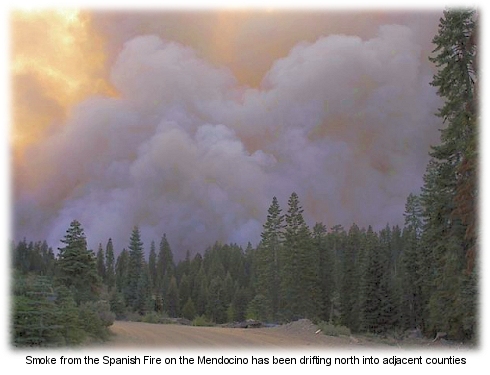
Resources on the fire today include 28 crews and 29 engines, five dozers, six helicopters, and ten water tenders, with a total of 774 personnel assigned.

NEW FIRE ON THE MENDOCINOSEPTEMBER 29 -- ALDER SPRINGS, CA: A fire on the Grindstone District near Alder Springs is estimated at 1,800 acres this morning, with no containment. The growth potential on the Spanish Fire is considered extreme, partly because of low relative humidities and steep terrain. The fire's torching and crowning in timber and heavy slash, with spotting out to a half mile from the main fire.
Forest visitors have been evacuated and portions of the Alder Springs Road (Highway 7) are closed; Walker's Type 2 team is inbound.
Ten crews, fourteen engines, four dozers, and nine helicopters are currently assigned to the fire, which is burning near the Alder Springs Work Center.
The cause of the fire, which started at Boardtree Campground, is under investigation. The Redding Record-Searchlight reported that winds blew smoke from the fire north yesterday, prompting many phone calls to local agencies. "We've had close to 300 calls since the fire started," said Trinity County Sheriff's Deputy Ray Hurlburt.

EVACUATIONS POSSIBLE ON CASCADE FIRESEPTEMBER 28 -- CHARLESTON, UTAH: Firefighters on Friday alerted residents near Deer Creek Reservoir dam to prepare for evacuation if the Cascade Fire approaches homes, but in Salt Lake and Utah counties, according to the Salt Lake Tribune, the state lifted a smoke advisory that had been in effect for two days because of heavy smoke.
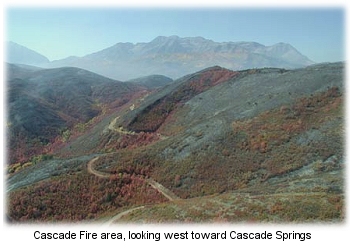 "Not much smoke was tapped this morning as in previous mornings, and the fire didn't really run away like it did on Thursday," said Andrew Church, meteorologist for the National Weather Service. "Not much smoke was tapped this morning as in previous mornings, and the fire didn't really run away like it did on Thursday," said Andrew Church, meteorologist for the National Weather Service.
Flames from a burnout jumped a road on the south end of the fire on Friday, triggering an alert to residents about two miles away. Engines from Wasatch and Utah counties were dispatched for structure protection, and also sent to a small community called Canyon Meadows, with about 12 residences.
Airtankers on Friday dropped more than 11,000 gallons of retardant to create a firebreak along the southern edge of the fire.
The fire started Tuesday when a 600-acre prescribed burn jumped lines and spread rapidly through thickets of oak and maple. The fire has caused a major haze of smoke across the Utah and Salt Lake valleys.
Muir's Type 2 team is handling the fire, which is burning in gambel oak, brush, and grass near Charleston. A closure order for a portion of the Pleasant Grove Ranger District is in effect. The fire was 70 percent contained last night at 7,790 acres.

THINNING OR WILDFIRE: WHICH COSTS MORE?SEPTEMBER 26 -- SEATTLE, WA: Without thinning, the worst is yet to come for fire-prone forests. That's one of the conclusions reached by University of Washington researchers in a recently published report.
Some forests in eastern Washington and eastern Oregon are crowded with as many as 3,000 trees per acre, putting them at high risk for wildfire. When high-intensity fires blaze through such areas, they turn forests into wastelands, sterilizing soils and damaging valuable wildlife habitat. Costs on a such a fire can run between $1,300 and $2,100 per acre in fire-fighting costs, lost buildings, economic suffering by nearby communities, and degraded waterways.
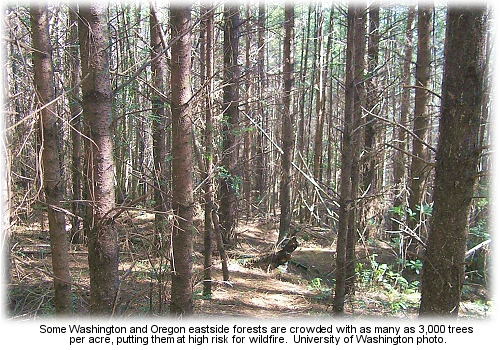
The new report attempts for the first time to tally the cost per acre of letting the worst wildfires burn. Thinning overly dense stands can cost $600 per acre or more; University of Washington researchers now are offering landowners, wildlife advocates, and policymakers a new software package that can compare how much fire danger is reduced against how much it costs to thin out fuels.
The new software integrates several computer programs offered by the U.S. Forest Service -- including one that models the way fire burns through a forest -- with the Landscape Management System program, which predicts how a forest grows and habitat changes after thinning.
On the Okanogan National Forest in Washington and the Fremont National Forest in Oregon, where some of the region's worst fires have occurred in recent years, the most effective treatment tested using the computer software preserved ponderosa pine and Western larch, while removing the smallest trees of other species until a targeted density was achieved. This approach typically left between 40 and 100 of the largest trees per acre. The trees removed rarely included any larger than 12 inches in diameter.
Unfortunately, though, markets are weak or nonexistent for the small-diameter trees removed under this option. The new software package helps weigh the economics of thinning in such cases to develop the most cost-effective approach.
"The challenge of developing long-term strategies to reduce wildfire risks across tens of millions of acres of inland West forest is daunting," said Larry Mason, lead author of the report. "The information to be considered is complex and the planning process may be formidable."
"We've tried to make the Landscape Management System and its support applications user-friendly," he said, "so that the general public, as well as professionals, can use it. There is less confusion and distrust if everyone can analyze the various choices for themselves."
With the software, a stand of trees can be "thinned" in various ways or "grown" on a computer. Simulated fires can be "set" to see if the fire stays on the forest floor or finds its way into ladder fuels and takes off as a crown fire.
Researchers found that the best treatment in case studies of the Okanogan and Fremont forests kept the ponderosa pine and Western larch, but thinned the smallest trees until reaching a target density of 45 square feet of "basal area" per acre. Foresters have long used basal area per acre rather than wood volume or number of trees to describe density. Basal area is determined by calculating the area of the surface across the diameter of every tree at chest height, and then summing the total.
Bruce Lippke, University of Washington professor and director of the Rural Technology Initiative, said that historic stands on the Okanogan and Fremont ran 30 to 60 large trees per acre. "Today the average is 1,000 trees per acre," he said, "and in some places it's as high as 3,000 trees. More than three-fourths of these two national forests are considered at high to moderate risk for crown fires, and both are fairly representative of forests in the Intermountain West from Canada to Arizona and New Mexico."
Though the researchers totaled the costs for suppression and destroyed buildings and burned timber, they weren't able to put a price tag on environmental costs such as loss of habitat or the release of tons of carbon dioxide into the atmosphere caused by wildfire.
"While the cost of acting may be high, the cost of doing nothing is greater," said Lippke.
The report, "Investigation of Alternative Strategies for Design, Layout and Administration of Fuel Removal Projects," was published by the university's College of Forest Resources as part of its Rural Technology Initiative. It's available online and can also be ordered by calling (206)543-8684. The Landscape Management System software is available for download at lms.cfr.washington.edu/lms.shtml at no charge.

SUGAR FIRE ON THE SIX RIVERS CONTAINEDSEPTEMBER 26 -- EUREKA, CA: The Sugar Fire, one of two fires that started along Highway 96 between Hoopa and Willow Creek, was contained yesterday, according to Rob McClelland, Lower Trinity District FMO, who said available resources kept it from getting out of hand.
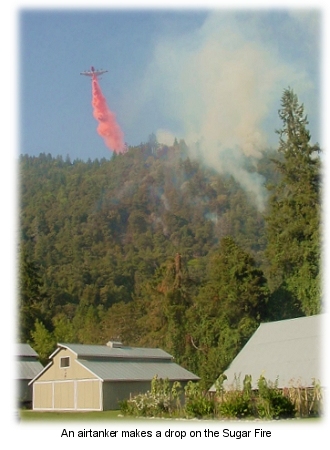 "The fire had potential due to extremely steep slopes," he said, "but thanks to the personnel and equipment we had available, it only took four hours for crews to get a handle on the fire." "The fire had potential due to extremely steep slopes," he said, "but thanks to the personnel and equipment we had available, it only took four hours for crews to get a handle on the fire."
There were 215 people on the fire.
Highway 96 was temporarily closed because of the trees and rocks in the burned area falling on the road.
Firefighters worked all night and had a line and a hose lay around the fire by morning. They were still fighting some small spot fires yesterday below the road.
The fire burned on private land and on Six Rivers National Forest lands.
Resources included four water tenders, three engines, three hotshot crews, two hand crews, a dozer, and one faller.
The second fire, on the Hoopa Valley Indian Reservation, was quickly contained at one-quarter acre. The cause of the fires is under investigation.
Air support was critical during initial attack and included helicopters from the Siskiyou, Lassen, Klamath, and Shasta-Trinity National Forests, and airtankers from the Winema and Shasta-Trinity National Forests.

FIREFIGHTER BURNED WHEN NORTHERN
CALIFORNIA FIRE FLARES UP AGAINSEPTEMBER 26 -- WEOTT, CA: The Canoe/Honeydew Complex in southern Humboldt County took off again when winds blew embers over firelines toward homes in Salmon Creek. A California inmate firefighter suffered second-degree burns when he and other firefighters retreated from a firestorm to planned safety zones. According to the Eureka Times-Standard, a precautionary evacuation notice was issued again, a day after an earlier one was lifted.
The 15,822-acre fire last night was listed at 60 percent containment. Hawkins's CDF team is managing the fires, which are about 16 miles north of Garberville in old-growth redwood, brush, and logging slash. Local up-canyon winds and dry conditions, according to the team, increased fire behavior on the Canoe Fire, and spotting has been a significant problem. Structure protection is still in place for 100 residences.
The Canoe Fire burned about 20 acres outside firelines yesterday, pushed by erratic ridgetop winds. The Santa Rosa Press-Democrat reported that more than 1,000 firefighters and support personnel are on the fire, which was ignited by lightning on September 3. Nearly 2,000 personnel are on the combined Canoe/Honeydew Complex; the Honeydew Fire south of Shelter Cove was 100 percent contained by yesterday afternoon after burning nearly 11,000 acres of rugged timberland and open range.
One of the residents preparing to evacuate was environmental activist Darryl Cherney, who lives in a remote area about three miles from the current fireline.
"The heart of countercultural land has been on fire for two weeks now since the massive and spectacular lightning storm that set over 200 fires," Cherney said in an e-mail message to associates. "Mother Nature means business."

SMOKE WARNING IN EFFECT FOR UTAH FIRESEPTEMBER 24 -- SALT LAKE CITY, UTAH: Unexpected wind blew a prescribed burn beyond the contingency area yesterday, and the Utah Department of Environmental Quality has issued a wildfire smoke health advisory for Utah and Salt Lake counties because of heavy smoke from the fire. The Cascade Fire, about 6 miles from Charleston, has grown to about 3,200 acres in the Cascade Springs area; it's moving north and east toward Wasatch Mountain State Park.
The Salt Lake Tribune reported that the fire was intended to clear about 600 acres of dense oak brush and maple on the Uinta National Forest. Before the winds picked up yesterday, the fire was moving at about 10 feet per minute. After winds increased to 25 mph the fire traveled at 70 to 80 feet per minute and was spotting up to 500 feet ahead of the flame front. Flames reached a high of nearly 80 feet.
A Type 2 team has been ordered.
KSL-TV reported that crews were warned this morning about the rugged terrain and possible gusting winds. Four crews are working in dense oak brush on steep slopes, along with 13 engines, a dozer, and four helicopters. Two airtankers are on standby at Hill Air Force Base.

SENATE DOUBLES FIRE FUNDINGSEPTEMBER 24 -- WASHINGTON, DC: The Senate increased fire funds by $400 million yesterday, nearly doubling the suppression money contained in a $20 billion Interior Department spending bill.
"These dollars will help mitigate the costs of fighting the terrible fires this season," said Sen. Conrad Burns of Montana. "Now we need to find a long-term solution to this problem so we're not facing it year after year."
The AP reported that the Forest Service and other fire agencies are expected to borrow $850 million this year to pay for suppression in this and previous years. Negotiators in Congress agreed on $319 million for fire as part of a separate $937 million emergency package of aid for victims of natural disasters. The House-passed bill provided $690 million for fire suppression, while the original Senate bill included $514 million.
The Alamogordo News reported that Sen. Jeff Bingaman of New Mexico on Monday introduced an amendment to the Interior appropriations bill that would give the USDA up to $250 million annually in additional fire funding. "This is intended to put an end to the Forest Service's practice of borrowing funding from key forest thinning programs -- and failing to restore those funds -- in particularly harsh fire seasons," said Bingaman. He said communities shouldn't have to choose between fighting fires and restoring forest health.
"We need to do both," he said. "If we don't put an end to the Forest Service's bad habit of raiding its forest thinning program, we will not make any gains in the long run to reduce the threat of wildfire in the West."
Both Burns and Bingaman neglected to mention that the agency's "bad habit" is caused by Congressmen's refusal to fund the fire agencies' budgets for the real cost of fighting fire.

CENTRAL OREGON COMPLEX WINDS DOWN
FOR FIRE AND RAMPS UP FOR REHABSEPTEMBER 23 -- IDANHA, OR: Oregon's big fire for the season, the 90,769-acre B&B Complex near Sisters, has but a 5 percent uncontrolled portion left today, and that's in an inaccessible portion of the Mt. Jefferson Wilderness. This area today was showing little or no visible heat, and the team managing the fire said escape was unlikely.
Most of the recent suppression activity has included fireline rehab, and will still take some time to complete; rehab as of today is nearing 95 percent completion. Crews on the complex are still mopping up hot spots and patrolling. Only a few interior smokes are still visible, and infrared mapping confirms that hot spots are few and far between. The northwest portion of the fire still has a few active smokes, and they have shown up more as the weather has gotten increasingly hotter and drier this week. Engine crews are out patrolling these areas.
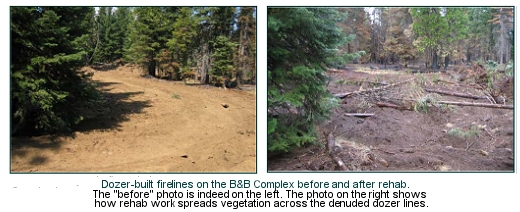
Major demobilization is under way, and Information Officer Brian Ballou says they have more than 10 miles of hose to pull yet on the west side of the fire.
Firefighter Ronnie Rivard told the Statesman-Journal that he and hundreds of other firefighters and rehab experts are fixing what's left of a $35.6 million suppression effort.
"You're never gonna know it was here when we're done with it," said Rivard.
It could take twice as long to rehab the fireline as it took to put it in, according to Kent Koeller with the Bend/Fort Rock Ranger District. "Foot by foot, they are trying to put everything back," he said.
Firefighters -- and the public -- are still faced with some major hazards across the fire area, including burned snags and burned-out stump holes. Fallers will be working on snags on Road 1210, and some fire areas might be closed even through the end of the year because of the risk of falling trees.
The east and west fire camps will be combined tomorrow, with the consolidated operation moved to the Sisters rodeo grounds.
A prescribed burn to improve sage grouse habitat is scheduled for tomorrow just north of the community of Brothers -- an 825-acre burn is planned for the project, which should take a couple days to complete. Updated information on fire closures still in effect is available online through the Willamette National Forest and Deschutes National Forest websites.

BREAKER BREAKS AND STARTS GRASSFIRE IN STILL-DRY COLORADOSEPTEMBER 23 -- ASPEN, CO: A fire above Ruedi Reservoir on Sunday was ignited when a powerline tripped a breaker and part of the breaker fell into dry brush, according to Basalt Fire Chief Scott Thompson. The fire was reported about noon when someone came looking for a fire extinguisher to put the fire out.
The Aspen Times reported that about three dozen firefighters from three departments responded. The fire, on a hillside with a 30 percent slope, was contained by dusk, but federal fighters patrolled the area overnight. They returned on Monday to mop up hot spots.
Fire season's not quite over.
Increasing the fire danger across the state, a mountain pine beetle infestation killed more than 600,000 trees last year; spruce and Ips beetles inflicted similar damage, according to the Denver Post. State and federal officials believe the damage this year will be worse.
Dave Silvieus, a district ranger on the White River National Forest, said 2,000 to 3,000 acres of trees in the forest have been ravaged by the spruce beetle this summer.
"That might double next year," Silvieus said. "In four or five years, it could be 30,000 to 40,000 acres."
Mountain pine and spruce beetles began appearing in Colorado in large numbers around 1997, and have doubled their population nearly every year. Jim Thinnes, a U.S. Forest Service silviculturist, said the cycle for the spruce beetle usually lasts 10 to 15 years. With numbers of dead trees rising from the rapidly spreading spruce beetle infestation, the outbreak probably hasn't reached its peak.

FEDS APPROVE $30 MILLION FOR BARK BEETLE WORKSEPTEMBER 23 -- SAN BERNARDINO, CA: An emergency allocation of $30 million to fight bark beetle infestations is good news in southern California, according to an AP report in the Sacramento Bee.
"This is very good news," said U.S. Sen. Dianne Feinstein, "especially for residents of San Bernardino, Riverside, and San Diego counties, where the bark beetle infestation is at its worst.
Years of drought and a severe infestation of beetles have killed nearly all the trees across much of the San Bernardino National Forest; 400,000 acres of forestland and about a million trees are affected in southern California. The Victorville Daily Press reported that the funding was sought by Feinstein and U.S. Rep. Jerry Lewis. Of the total, $10 million is granted to the U.S. Forest Service; the remaining $20 million is distributed among state and private forestry agencies.
The funds were approved just as fire danger in southern California reaches its peak with the onset of fall Santa Ana winds.
"The situation in our southern California mountains is a disaster waiting to happen," said Lewis, "with the worst fire danger in the nation surrounding 60,000 residents."

NORTHERN CALIFORNIA FIRES UPDATESEPTEMBER 21 -- REDDING, CA: Winds pushed two fires in Humboldt County Friday, launching a spot fire from the Canoe Creek Fire in Humboldt Redwoods State Park to private land and advancing to within a half mile of structures in the Salmon Creek area. The Honeydew Creek Fire in the King Range is being managed by Hawkins's CDF team, and is estimated at 11,200 acres with 25 percent containment.
The fires north of Garberville are burning in old growth redwoods, brush, and logging slash. The Honeydew Fire yesterday moved both south and north, and aerial suppression was limited by both smoke and wind on the Canoe Fire. Structure protection is in place for 450 homes and 20 commercial properties.
The Eureka Times-Standard reported that daily community information meetings are scheduled at the Shelter Cove Community Center.
About 900 personnel are assigned to the fire.
Crews on the Loma Fire on the Shasta-Trinity National Forest are hoping for full containment today, according to Steve Funk, a CDF information officer. He told the Redding Record-Searchlight that a red flag warning was still in effect yesterday. Szczepanik's Type 2 team is on the fire, which is burning west of Weaverville; the 3,000-acre fire was 70 percent contained last night.
Two remote ranches about six miles north of Highway 299 remained evacuated late Saturday, and the Big Flat, Big Bar, Hayden Flat, and Skunk Point campgrounds are still closed to the public.
The Grindstone Complex on the Mendocino is about 75 percent contained at 7,926 acres. The Deafy Fire is the only active fire still burning within the complex, which is being managed by Dietrich's Type 2 team. Full containment is expected later this week.

AFTERMATH OF FIRES: IMPROVED HABITATSEPTEMBER 19 -- EDMONTON, ALBERTA, CANADA: The Syncline Ridge Fire may have smoked out some of the tourism dollars in Jasper National Park this summer, but a well-known naturalist says the fire-dependent ecosystem of the Park needed the fire.
"Overall it was probably a good thing, strange though it may seem," said author Ben Gadd, a Jasper resident of more than two decades who lectures on national parks.
The fire, which took off when prescribed burns got away from Parks Canada staff in spring, burned more than 25,000 hectares (61,000 acres). Gadd said that without fire, the forest can't support wildlife that depend on meadows and brushy areas. And because most of the Athabasca Valley burned this year, more prescribed fire will be needed in future decades to create variety.
"If we're to get all that species diversity back," said Gadd, "we have to have a landscape in the Rockies that has all these various things -- not just deep forest, but forest that's young and growing, and forest that's just ten years old, and meadows and burned areas and all that."
According to the Edmonton Sun, the fire also gave the park's elk, whose population has soared because wolf numbers are down, a huge new grazing area. Park observers say the new feeding grounds could reduce the number of habituated elk in the Jasper townsite.
On Oregon's Deschutes National Forest, biologists say that deer, elk, and fish in the area of the B&B Complex will survive and possibly thrive despite the 91,000 acres that burned this summer. Though the fire completely burned some areas, the fire severity over the complex was mixed -- and in many areas minimal.
An Associated Press story in the Register-Guard said that wildlife may benefit from the fire.
"It's not a total forest devastation out there," said Lauri Turner, a biologist with the Deschutes.
The Bend Bulletin reported that the increase in herbaceous growth will boost the forage base for deer and elk. The fire area, summer range for about 6,000 mule deer and at least 400 elk, has a lot of green remaining.
"The fire is definitely a mosaic burn," said Turner. "There are areas that experienced very high intensity burns that kind of wiped out everything. And then there are areas that experienced a minor underburn to an occasional torching of trees."
And Steven George, a biologist with the Oregon Department of Fish and Wildlife, said he's seen some preliminary information estimating that about 10 percent of the burned area was consumed at a high intensity. A burn severity map developed on the complex indicates that about 10 percent of the fire area (8,865 acres) burned at high intensity. Another 33 percent (30,554 acres) burned at moderate intensity, 54 percent (50,025 acres) was mapped at low intensity, and about 3 percent (2,471 acres) was unburned.
Plants favored by deer and elk, such as serviceberry and bluebunch wheatgrass, will recover in the burned areas. George said habitat areas were expanded by the fire.
"They'll go in and start snooping around even when it's still hot," he said. And the bull trout in the area are making their annual spawning runs this month.
"Apparently, the fire didn't inhibit their desire to spawn," said Steve Marx, another ODFW biologist. He said a higher than usual number of bull trout spawning beds have been counted this year. Another AP report noted that the fall chinook run at the Bonneville Dam on the Columbia was so large last week that some fish were crushed on the fish ladders. Last Thursday, Friday and Saturday, more than 40,000 fall chinook fought their way over the dam. On Sunday, 39,642 climbed the ladders there. All four days surpassed the previous one-day record of 39,376 fall chinook set in 1987; the new high mark was recorded last Thursday, with 45,884 fish.

FIRE FUNDING PROCESS IS "ASININE"SEPTEMBER 17 -- WASHINGTON, DC: President Bush defended his healthy-forest plan on Tuesday while members of Congress fumed that his administration is diverting money from healthy-forest projects to fight fires.
Bush's plan, approved by the House and still pending in the Senate, would make it easier for federal land managers to conduct fuels management projects with thinning and burning. It also would streamline and expedite the environmental and public appeals processes.
But according to a Gannett News report, 40 members of Congress say the administration stopped managing the forests when it shifted money out of the Forest Service's fuels management accounts to help pay for fire suppression.
On Monday, the lawmakers fired off a letter urging House leaders to add money that the Forest Service and Interior Department need to fight fires this year.
"We need the money to fight the fires," said Rep. Dennis Rehberg of Montana, "but don't devastate other programs, especially the hazardous fuels program."
The Forest Service in August "borrowed" $400 million from non-fire accounts to supplement the $418 million it already had received this year for fire funding. House leaders, at the insistence of the White House budget office, dropped $289 million in suppression money from an emergency spending bill.
Even if the money is paid back soon, foresters could lose at least two months of work this year.
"This is asinine," said Rep. Mike Simpson of Idaho. "There's s not another word for it."
The Tucson Citizen reported that Arizona Gov. Janet Napolitano says she doesn't think Congress will provide adequate funding for thinning.
"I am worried that next June I will be standing behind a podium at yet another major fire without any plans undertaken to begin the kind of thinning and treatments that are required on the federal lands," she said.
Rep. Peter DeFazio of Oregon complained that Bush's plan doesn't include funding for future forest thinning.
"They don't seem to be able to screw up the political courage to ask for the money it takes," he said.
"I can't believe any senator would say, 'I'm not going to vote for this bill because there's not enough budget here,'" said Bush. "That's not the way it works."

VAIL'S TEAM TO HAND OFF THE GRINDSTONESEPTEMBER 16 -- STONYFORD, CA: Smoke from the Grindstone complex filled the skies above Tehama County yesterday, with heavy winds pushing the smoke north toward Redding. Smoke on Sunday shrouded the Ukiah valley with a low pressure cell over Mendocino and Lake counties. The Mendocino County Air Quality Management District issued a health alert for those sensitive to air pollution, according to the Ukiah Daily Journal.
The Redding Record-Searchlight reported that winds are expected to shift tomorrow, moving the smoke toward Sacramento.
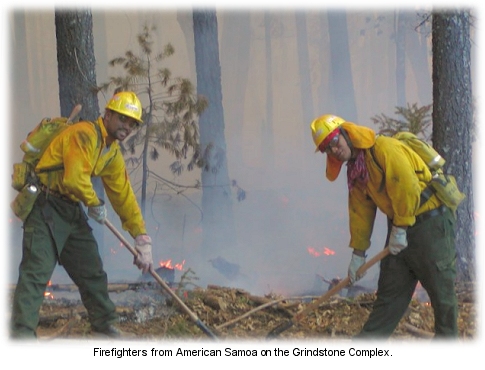
Driving times of two hours or more are causing travel delays and logistical problems for crews and other resources, so the team's instituted the use of coyote tactics, spike camps, and some 24-hour shifting on the fire. Crews yesterday burned out from existing dozer lines and continued mop-up; the Deafy Fire could still spread up the Anderson, Eel, and Cold Creek drainages. Fire behavior is expected to be moderate.
Deafy is the only active fire in the complex; 22 other fires have been controlled and 13 contained. Of the largest fires, the Deafy Fire is at 4,544 acres, the Happy Camp is 1,481, the Felkner is 407, the Anderson II is 284, and the Estelle Fire is 221 acres. The Bowman Fire near Ski-Hi was contained at 212 acres.
The fire perimeter amounts to about 54 miles of fire perimeter. The Deafy is the only one of the 39 fires on the 7,722-acre complex that's still active, and containment on the complex is at 35 percent. Vail's team will transition off the incident on Thursday morning.
Costs on the complex have reached $8.3 million, which is about 65 percent of the Mendocino National Forest's total costs for all the fires caused by the September 3 lightning storm. Fires at the forest's two other complexes -- the Smokehouse and Covelo -- were contained last week.
Forest officials closed portions of road M6 on Sunday afternoon, but the Gravelly Valley air strip and Forest Highway 7 were opened over the weekend.

FIRE SEASON TAB COULD RUN $950 MILLIONSEPTEMBER 15 -- SISTERS, OR: The Forest Service expects to spend at least $773 million on firefighting this fiscal year, about $355 million more than allocated in the current budget. And the total bill could reach $950 million before the 2003 season ends.
At a cost of $1 million per day, the B&B; Complex in Oregon has racked up an estimated $30.6 million in suppression costs since the fires started August 19. As of yesterday, 60 engines, 46 crews and 11 helicopters, with a total of nearly 2,000 personnel, were still on the complex, now 86 percent contained at 90,824 acres.
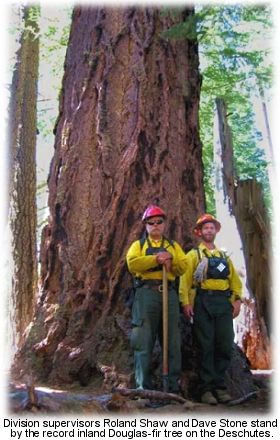 The record-size Douglas-fir within the perimeter of the complex, contrary to rumor, was not killed by the fire. The record-size Douglas-fir within the perimeter of the complex, contrary to rumor, was not killed by the fire.
According to the Statesman-Journal, crew costs on the B&B have run from $5,500 per day for a hotshot crew to a range of $7,000 to $11,000 per day for a contract crew. About a third of the total cost for the complex is wages -- mostly for hand crews, engine crews, and other front-line personnel. About a fifth of the cost has paid for equipment -- the operation of engines, dozers, trucks, and other ground equipment.
The usual big-ticket item in suppression expenses is aircraft. An airtanker making a 2,500-gallon drop can run about $4,000 per load. Heavy helicopters, which can deliver 10,000 gallons per hour, run $25,000 or more per day. Another $2 million on the B&B Complex was spent on supplies, the caterer's reimbursement has run about $70,000 per day, and an 8-person shower unit runs between $2,200 and $2,600 per day.
The cost of the B&B pales, though, compared with the $155 million spent on last year's 500,000-acre Biscuit Fire in southern Oregon -- the largest in at least a century.
Ken Snell, regional deputy director for fire and aviation with the Forest Service and BLM, said two major factors have increased the costs of wildfire suppression: sustained drought in the West, and increased fuel loads in overgrown forests.
"We're finally paying the price," said Snell.
When fire funds ran out last month, Forest Service managers had to divert funds from other programs to pay for suppression. The Casper Star-Tribune reported that this year's fires will cost about $355 million more than what was allocated in the budget. To cover the difference, the agency took money from other programs -- such as maintenance, research, brush disposal, and recreation.
In July, some members of Congress voted against an emergency disaster relief bill after House leaders stripped $289 million in fire suppression funds from the bill. The measure was passed 352-60.
The omission of the firefighting money left many Western lawmakers seething. U.S. Rep. Barb Cubin of Wyoming, for example, is continuing to press for an emergency allocation.
"She's outright just demanding that money get back there for that," said her press secretary Joe Milczewski. "She's letting everyone know that it's just ridiculous not to have wildfire funding."

WEEKEND FIRE BURNS 700 ACRES NEAR BILLINGSSEPTEMBER 15 -- LOCKWOOD, MT: With the Montana fire season winding down after the onset of fall rain and cooler temperatures, residents found yesterday that fire danger's still pretty high. A 700-acre fire yesterday afternoon burned two structures and threatened nearly 30 homes in the Pine Hills area of Lockwood, a subdivision of steep hills about 8 miles east of Billings.
Incident Commander Robert Guenther with the Lockwood Fire Department told the Billings Gazette that the Pine Hills Fire was nearly contained by sunset. The fire started at about 1:30 p.m. on the east side of Interstate 90. Local residents said the fire ran up a valley and jumped a road, spreading quickly to the northeast. Guenther said state airtankers were especially helpful; two SEATs were on the fire about 90 minutes after it started, and a pair of heavy tankers followed.
"They played a critical role," said Guenther.
The fire was stopped early Sunday evening just short of Bill Weis's home. He stood on his porch watching snags burning inside the fireline. "We dodged a bullet," said Weis. "It's not a good thing when you look up and see an airtanker over your house."

SMOKEHOUSE CONTAINED, BUT CREWS
ON MENDOCINO WARY OF WINDSSEPTEMBER 12 -- STONYFORD, CA: Demobilization is wrapping up on the 1,210-acre Smokehouse Complex -- fully contained Wednesday evening -- and a target of this evening is set for containment of the Covelo Complex fires, according to the Ukiah Daily Journal. But a red flag warning issued Wednesday for high winds and hot conditions is still in effect, with winds of 20 mph or better continuing today across the Mendocino National Forest and the valley below.
Temperatures ranged from 83º to 93º and are predicted to increase. The 240-acre Covelo Complex is burning in timber about 15 miles east of Covelo, and according to Mullenix's Type 2 team, fire behavior was minimal yesterday.
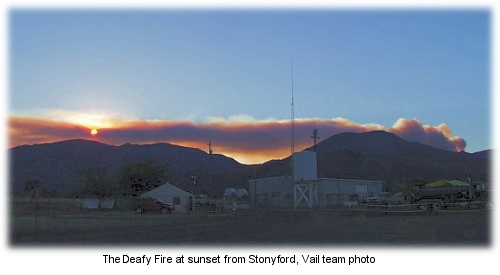
The Grindstone Complex, about 20 percent contained at 4,045 acres, has two major fires still active -- the Happy Fire at 1370 acres and the Deafy Fire at 925 acres. The Happy Camp and Felkner fires are expected to burn together, as are the Anderson II and Deafy fires. There are 39 confirmed fires on the complex; activity yesterday included flare-ups and short-range spotting on the Happy Camp Fire, with slow backing and flanking surface fire on the Deafy. Structure protection remains in place for 11 residences.
Red flag conditions could radically affect fire spread, according to Scott Vail's Type 1 team. The potential for the Deafy Fire to spread west is of particular concern if the current north winds rotate to the northeast and align with the Anderson Creek and Corbin Creek drainages.

FDNY ON THE B&BSEPTEMBER 11 -- SISTERS, OR: Two years ago today, in New York City, firefighter Harry Meyers was confronting a nightmare: the terrorist attack on the World Trade Center. Today Meyers and five others from the New York Fire Department are on the B&B Complex in Oregon, working with wildland firefighters and learning how the Incident Command System handles a large-scale long-term incident.
Two years ago Meyers, commander of the FDNY's Manhattan Borough, was on his day off in upstate New York. He headed for Ground Zero and was the operations chief in charge of the rescue effort. He didn't know where three of his sons were -- one NYPD officer and two FDNY firefighters -- until the evening, when he learned they were safe. He didn't leave the site for weeks.
"September 11 showed us we need to be more concerned with long-term events," he told the Bend Bulletin.
Austin Horan, a battalion chief for Lower Manhattan, said the B&B operation is exactly what the New York firefighters need to see. "FDNY has resources, manpower, and training," he said, "but we need to coordinate to give us back what we had before -- control."
Meyers has followed incident commander Kim Martin since Sunday, when the New York crew arrived at the fire camp. He was impressed with the way the tent city at the Sisters rodeo grounds emerged as if from nowhere.
The New York crew is the fifth group of six teams to visit wildfires this summer in a job-shadow program. The first four teams trained on Montana fires.
In August, FDNY personnel shadowed Bill Swope's type 2 team on the Cherry Creek Fire for a week in Montana.
"The ICS helped create organization out of chaos," said Mike McPartland, chief of Battalion 11 on the upper west side of Manhattan. "We saw it at work on 9-11 and realized we could learn it and use it, too."
Several Type 1 incident management teams were assigned to the disaster two years ago, and firefighters there were impressed with the teams' function there. "The level of organization and cooperation these people brought to the incident was incredible," said New York Battalion 18 Chief Ray Goldbach. "We see this as great training for the next big incident we face."

WITH GRATITUDESEPTEMBER 11: To all of you out there, whether you are wildland firefighters, volunteers, structural firefighters, law enforcement personnel, emergency medical responders, or support of any other kind in emergency services, on this day, in memory of those we lost -- THANK YOU.

RAIN HELPS ON THE B&B COMPLEX,
BUT WINDS EXPECTEDSEPTEMBER 10 -- SISTERS, OR:
Cooler temperatures and rainfall have allowed firefighters to engage in direct-fireline construction near Marion Lake; some areas got over a half inch of rain in the last couple days. Dale Gardner, the incident commander for the portion of the complex west of the Cascade Crest, said it's important that crews make good progress before the weather changes and east winds pick up. "The rainfall we've received to date has been helpful," said Gardner, "but has done little to change record-low fuel moistures in the large-diameter fuels."
Fire managers are expecting winds from the northwest at 8 to 12 mph in the higher elevations, with possible east winds gusting to 35 mph by Friday or Saturday.
The west side of the complex is estimated at 15,000 acres, with 12 crews assigned and more on order. Air resources are shared across the entire complex; seven heavy helicopters, three mediums, and two light helicopters are assigned.
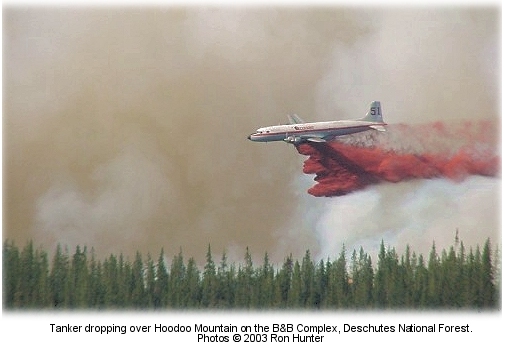
Highway 20 traffic is still delayed because of helicopter traffic over the road. Travelers are cautioned to watch out for vehicles and hazards such as trees, rocks, and limited visibility caused by smoke. Detailed road closure information is available on the complex website at bandbcomplex.com
The Register-Guard reported that fire danger on the Willamette and other neighboring forests dropped to a rating of "low" yesterday, down from "medium" on Monday and "high" last weekend. Fire information officer Robin Vora said he drove through the fire area yesterday, and only a few areas were actively burning.
"As far as I can tell, it's just a stump over here or a snag over there," he said. "There's no fire spreading."
Kim Martin's Type 1 team, which is handling the east side of the complex, said the fire's now grown to 90,452 acres, with 55 percent containment. More than 2,100 people are working on the fires. Over 42,000 acres of the fire is on the Deschutes National Forest; about 23,000 acres is in the Mt. Jefferson wilderness, 1,100 acres is private land, and nearly 4,000 acres is on the Warm Springs Confederated Tribes reservation. Burned area in the Mt. Jefferson wilderness is 17,300 acres, and another 2,700 acres are on the Willamette National Forest.

RED FLAG ON THE GRINDSTONESEPTEMBER 10 -- STONYFORD, CA: Brisk winds this morning have prompted a red flag warning on the Grindstone Complex, and firefighters are expecting high temperatures, low humidity, and more wind. The Grindstone Complex now includes three major active fires ranging between 150 and 600 acres.
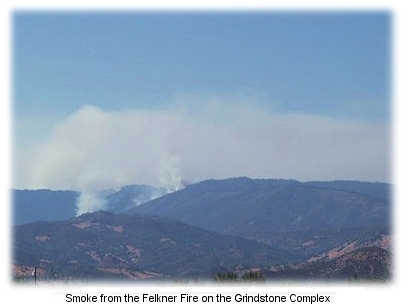 Weather problems and fire behavior are challenging suppression efforts on the Happy Camp Fire, the Happy Camp II Fire, and the Deafy Fire. Fire managers and making contingency plans for fires that are expected to burn together. Weather problems and fire behavior are challenging suppression efforts on the Happy Camp Fire, the Happy Camp II Fire, and the Deafy Fire. Fire managers and making contingency plans for fires that are expected to burn together.
The complex is estimated at 10 percent containment this morning, with 3,025 acres burned. There are 39 confirmed fires in the complex.
The Chico Enterprise-Record reported that the fires grew nearly 1,000 acres yesterday; the list of threatened residences was reduced from 21 to 11 when the Bowman Fire was contained.
Resources include 33 crews, 73 engines, 16 dozers, 13 tenders, two fixed-wing aircraft, and a dozen helicopters.
The Smokehouse Complex, also on the Mendocino, was 95 percent contained yesterday at 1,210 acres. There was no estimate on containment on the Covelo Complex, which is in remote country, but its size was estimated at 160 acres. Mullenix's Type 2 team has been assigned to the Covelo.

CODFISH FIRE MORE THAN HALF CONTAINEDSEPTEMBER 07 -- FORESTHILL, CA: The 830-acre Codfish Fire near Foresthill is about 60 percent contained today; it's burning on Codfish Ridge in steep and rugged terrain on the Tahoe National Forest.
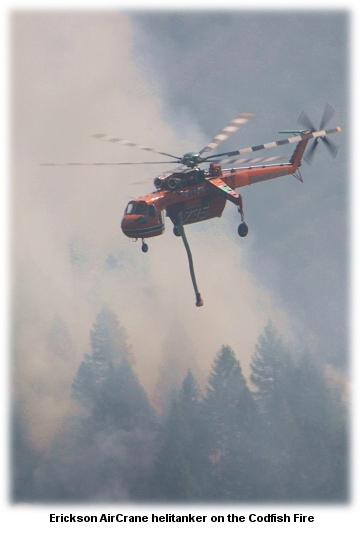 One of dozens of fires burning in northern California after lightning storms last week, the Cod Complex is being managed by the NorCal II team. One of dozens of fires burning in northern California after lightning storms last week, the Cod Complex is being managed by the NorCal II team.
Information Officer Anna Payne said burnout operations and contingency lines have been completed in expectation of forecasted increased winds this afternoon.
Some rehab efforts have begun, but the north fork of the fire is still active. Goals today include keeping the fire west of Deadwood Ridge, east of the West Branch of Eldorado Creek, and south of the Foresthill Divide road.
A Forest Service Fire Behavior Research Team has set up sites on the complex to study changes on fire behavior in areas of treated and untreated fuels.
According to the Sacramento Bee, fire crews will be busy enough this week that CDF has canceled all scheduled firefighters' days off for the week.

RED FLAG ON MONTANA FIRES TODAYSEPTEMBER 07 -- FRENCHTOWN, MT: The Fish Creek Complex on the Lolo National Forest, now 50 percent contained at 35,700 acres, is expecting red flag conditions this afternoon.
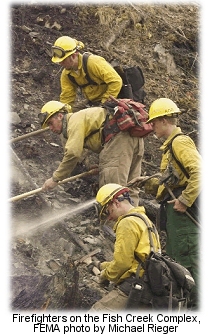 The Missoulian reported that firefighters in camps around western Montana last night were waiting for the "weather-changing pattern" predicted for today. The Missoulian reported that firefighters in camps around western Montana last night were waiting for the "weather-changing pattern" predicted for today.
It could bring rain -- but it's the winds that have people on edge.
Information Officer Christine Ayers on the Blackfoot Lake Fire said they've had no wind for a week, so the fires have sat and baked the moisture out of the forests.
At camp they hear the phrase "watch-out situation" about a thousand times an hour, she said.
"Before we get any rain, we could get major winds," Ayers said. "This weekend, everybody's on pins and needles."
Lohrey's Type 1 team is handling the Fish Creek Complex, and they have the U.S. Army Task Force Steel Dragon regiment assigned. The complex, which includes nine fires, is about 35 miles west of Missoula.
Structure protection is in place for 195 homes and one commercial property; firefighters worked yesterday on the east side of the Thompson Creek Fire where the fire burned across containment lines on Friday. They will continue mop-up around the fire today to close in the remaining gaps on the north and south flanks.
A combination of windy conditions, low humidity, warm temperatures, and an unstable air mass will combine to produce Red Flag conditions this afternoon and evening, along with isolated thunderstorms and wind gusts up to 40 mph. The forecast says rain will come at 10 p.m., and it will rain all night, according to Information Officer Andy Williams.
"The weather has changed," he said. "There's high clouds, and the wind has sort of freshened a bit. There's a sense that something is changing." A red flag was issued by the Weather Service for gusty winds in the Idaho Panhandle, with fire weather watches issued for gusty westerly winds and low humidity in portions of Idaho and western Montana. A cold front with rain will move across the Pacific Northwest today and into Idaho and western Montana tonight.

FIRE NEAR ASHLAND THREATENS 70 HOMESSEPTEMBER 07 -- ASHLAND, OR: Fires ignited by lightning in the hills south of Ashland are threatening some 70 homes; burning in timber, slash, brush, and grass, the 9-05 Complex of 21 fires has closed the Dead Indian Memorial Highway. The fire, at 675 acres, was estimated at 75 percent containment last night.
Oregon Department of Forestry Fire Prevention Specialist Dennis Turco told the Ashland Daily Tidings they're watching for a wind change. "We're expecting possible westerly winds at 6 to 12 miles," he said. "Anytime you get wind it can cause problems for us."
The fire was reported late Friday afternoon; lightning has set off more than 50 fires in southern Oregon since Thursday. Airtankers worked the fires, which were burning in steep terrain. Containment is predicted for tonight.

BRIDGE FIRE THREATENS 1,500 HOMESSEPTEMBER 06 -- SMILEY PARK, CA: A brushfire pushed by erratic winds is threatening about 1,500 homes east of Los Angeles today, with at least 400 home evacuated along the edge of the San Bernardino National Forest. Domanski's Type 2 team is working with the Running Springs Fire District and the San Bernardino County Fire Department on the fire, which is threatening to burn into bug-kill timber and heavy brush in high-density interface areas.

Highway 18 is closed between Sky Forest and Big Bear dam, and only residents are being allowed through. Highway 330 is closed from Live Oak at the tip to Highland at the bottom, and mandatory evacuations have occurred in seven different communities. Structure protection is in place for 1,500 homes, and more erratic winds with possible thunderstorms are forecast.
The fire took off yesterday afternoon and burned about 1,400 acres by evening. According to the San Bernardino County Sun, the fire exploded out of the foothills north of Highland; a high school in Lake Arrowhead was designated as evacuation headquarters. By 8 p.m. about 500 people were at the high school.
The speed of the fire stoked fears that it might be the monster blaze everyone has been dreading. Firefighters said Friday night that they could not predict when the evacuees could return to their homes; the fire is expected to burn through the weekend.
Two firefighters were treated for heatstroke, and a third may have suffered a back injury. Forest Service officials said last night they had requested additional airtankers and helicopters.
The fire was first reported about 3:00 p.m. west of Highway 330, and it grew from 8 acres to 100 acres in about an hour. By 5:00 p.m. evacuation orders had been issued for 250 homes in the Smiley Park area of Fredalba, the lowest-lying community along the highway.

About 1,100 firefighters were working the fire, with 65 engines, 24 crews, eight airtankers, two helicopters, seven dozers, 14 water tenders, and a pair of air-attack planes assigned. Officials credited the airtankers with saving structures.

B&B COMPLEX TAB REACHES $17 MILLIONSEPTEMBER 06 -- SISTERS, OR: Crews held their lines overnight on the B&B Complex, keeping the Booth and Bear Butte fires from spreading into commercial timber on the Confederated Tribes of Warm Springs reservation. The two fires have burned together and now cover 83,000 acres, according to a report by KATU-TV, with over 2,000 firefighters assigned.
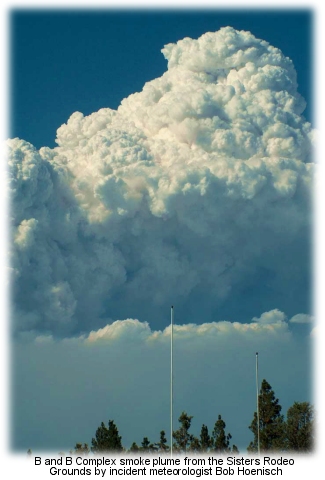 Camp Sherman was evacuated again on Thursday when the fire burned to within three miles of the community. Camp Sherman was evacuated again on Thursday when the fire burned to within three miles of the community.
The fire yesterday burned another four miles in under an hour, sending a plume of smoke up to 35,000 feet and raining down embers and ash.
Incident commander Bob Anderson met with Camp Sherman residents yesterday.
"I'm sorry we all meet again in the evacuation center," he said. "We saw some very erratic fire behavior yesterday."
The complex suppression costs now have reached $17 million.
Another Type 1 team is on order; the fire's burning in timber with heavy ground fuels on the Deschutes National Forest west of Sisters. An inversion yesterday in the Metolius River drainage slowed the fire till mid-afternoon; structure protection is in place for 120 homes and 13 commercial properties.
Local residents barely had time to return home from an evacuation before they got the order to pack up and leave again.
"It's been nerve-racking," said Virginia Dick. "I have had more fun than this. All the adventure wears off after about one day."

GRINDSTONE COMPLEX -- 55 FIRES AND NO ROADS INSEPTEMBER 05 -- STONYFORD, CA: The Grindstone Complex on the Mendocino National Forest tonight includes over 650 acres, comprising 55 different fires in the foothills west of the northern tip of the Sacramento Valley. Vail's Type 1 team late today said that 11 of the initially identified fires on the Grindstone Complex were contained -- fires ranging from under one acre to over 100 acres.
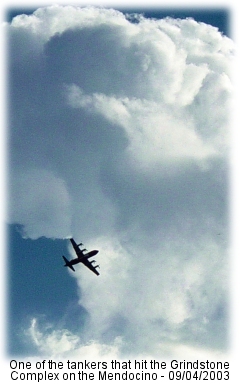 The largest of those today was the 170-acre Bowman Fire. The largest of those today was the 170-acre Bowman Fire.
The Smokehouse Complex in Lake County was estimated at 250 acres with 13 active fires; the Covelo Complex included six fires of 111 acres. Four new fires were identified this afternoon, but all were 30 acres or less.
Just west of the Bowman Fire, a priority today was the protection of the Ski-Hi community of cabins, a small group of privately owned residences adjoined by private timberland and national forest land. Most of the remote properties in the area are owned by local residents who have, for several decades, provided wildland fire safety for themselves and their neighbors -- defensible space with or without the help of the Forest Service and other regional funding sources for wildland-urban interface fuels reduction projects.
Mostly they've just done it on their own -- when federal funding grants for such projects were turned down -- and some of those mountain residents yesterday had firefighters camping in the meadow outside their cabins.
The steep slopes, drought-parched foothills, and chaparral-choked drainages cause long-time residents and fire-savvy veterans to shudder when they consider late-summer fire on the Mendocino. It was 50 years ago this summer that the Rattlesnake Fire, just a few miles north, killed off a crew of firefighters in the same fuels in the same country in the same kind of weather.
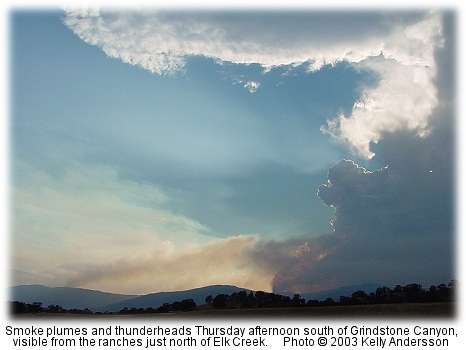
Firefighters on the Grindstone Complex have been keeping an eye on the weather forecasts; predicted southerly winds and low RH are only one of the challenges. Another is access -- or lack of it. There are but a few ways to get to a fire. Firefighters can hike in there, drive there, fly there, or parachute there. And on the Mendocino -- the only one of California's 18 national forests that's not crossed by a paved road -- that's a problem when it comes to wildfire suppression.

MONEY TO BURN??SEPTEMBER 05 -- WASHINGTON, DC: Congressional investigators say that $3 million in "improper, wasteful, and questionable purchases" has been made by U.S. Forest Service employees -- over $1 million of which was on government credit cards.
ABC news reported today that much of this was done in the name of Smokey Bear. An audit released today by the General Accounting Office cites the Forest Service for what was called "improper, wasteful, and questionable purchases," including:
- $4,843 in premium cable TV channels for forest rangers
- $1,031 in jewelry from Meier & Frank in Salt Lake City
- $2,295 for a bunkhouse pool table
- $12,250 for two fish costumes and a salmon tent to promote Smokey Bear
According to the ABC report, the expenses total over $2 million. The GAO report cited the risk of "waste, fraud, and abuse" at the same time that nearly every non-fire program or budget area in the U.S. Forest Service has recently had to fork over its budget for fire suppression -- because of the Congressional refusal to fund federal fire suppression without the necessity of federal "borrowing" from non-fire budgets in time of fire budget crises.
Senator Charles Grassley of Iowa told Agriculture Secretary Ann Veneman that she's accountable.
"There tends to be an attitude that it is the government's money," he said. "There isn't anything like 'the government's money'; it's all taxpayer money."
There weren't any reports available on how Grassley thought federal fire should be funded. He said he thought government employees should be "the most trusted people in all the world."

$50,000 REWARD FOR ARSONISTSEPTEMBER 05 -- UKIAH, CA: A rash of suspected arson fires in Mendocino County has prompted investigators to issue a call for public help. In the last two weeks, according to the Press-Democrat, a dozen suspicious wildland fires have started in Mendocino County, including two that were set within two hours of each other along Highway 101 north of Laytonville. The fires cost CDF at least $400,000 to fight.
Since then, firefighters suspect that numerous other local fires may be arson-caused, including fires near Ukiah High School, near Mill Creek Road, and around Lake Mendocino.
"We're experiencing an unusual number of suspicious fires this season," said Tracy Boudreaux with CDF in Willits. She said people can call the local hotline number at 459-7422.
"We need every bit of help we can get," said CDF's Karen Terrill. She explained that people calling an arson hotline at (800)468-4408 can receive up to $50,000 for information leading to the arrest and conviction of an arsonist.

NEEDLE FIRE DOUBLES IN SIZESEPTEMBER 05 -- MAZAMA, WA: The Needle Fire on the Okanogan-Wenatchee National Forest has doubled in size to 6,000 acres, according to a report by KIRO-TV. Berndt's Type 2 team is on the fire, which is burning downhill on both sides of the Methow River and into Trout Creek northwest of Mazama.
Okanogan County sheriff's deputies went door to door yesterday to about 75 homes to warn residents to be prepared to evacuate. About a third of the residences are year-round homes, the rest vacation cabins. The fire was ignited by lightning early in August, part of the Fawn Complex of fires, but had held at about 20 acres till last weekend. The fire has closed a portion of the Pacific Crest Trail near Harts Pass.

NORTHERN CALIFORNIA LIGHTS UPSEPTEMBER 05 -- REDDING, CA: More than 5,000 firefighters have been dispatched to scores of lightning fires across northern California, and dispatchers are scrambling for more resources from other regions. Veteran firefighters are remembering the season of 1987, when an August lightning storm set off 1,200 fires that burned 740,000 acres. Eleven firefighters died.
The Sacramento Bee reported that the Codfish Fire on the Tahoe National Forest was burning on steep, rocky slopes east of Foresthill.
"This is definitely a hotshot fire," said Dewey Rebbe, a hotshot from New Mexico. "The ridge is steep, inaccessible, roadless."
The fire camp on the complex was nearly deserted yesterday, with crews on the ridge in spike camps.
"Once they're on the line, it's easier just to keep them out there," said Anna Payne, a fire information officer on Wendt's Type 2 team. "And it's safer. They'll be there in case the fire flares up during the night."
The complex was reported last night at 550 acres, with containment estimated at 15 percent. Another complex of fires across Tehama and Glenn counties, totaling over 700 acres, was nearly contained last night, but the Smokehouse Complex northeast of Potter Valley had reached 250 acres with no containment. Szczepanik's Type 2 team is assigned to the fire.
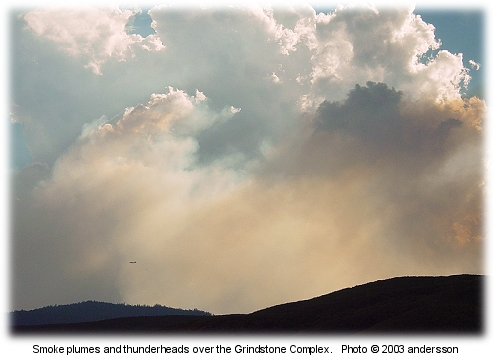
A Type 1 team headed up by Scott Vail took over the Grindstone Complex on the Mendocino National Forest yesterday afternoon. It includes more than 50 fires burning in chaparral on steep slopes west of Elk Creek, and was estimated last night at 450 acres.

FEDERAL OFFICIALS TO TEST JUMBO JETS FOR FIREFIGHTINGSEPTEMBER 05 -- RIVERSIDE, CA: The U.S. Forest Service has tentative plans to assign jumbo jets to airtanker bases next year, and plans to issue a request for proposals for new airtankers this fall.
"There are at least two efforts," said Tony Kern, the USFS aviation director. "One involves a DC-10. The other involves 747s. You'd never see a fleet of twenty of these things, but you might see a fleet of ten."
According to a report by the Press-Enterprise, the "supertankers" would carry between 12,000 and 24,000 gallons; Kern said no formal proposals have yet been submitted, but that Forest Service officials may issue a request for proposals early this fall for all categories of new airtankers, including jumbos. Consideration of the supertanker concept is part of the government's plan to modernize the national airtanker fleet; over the next five years, the USFS modernization plan calls for 50 firefighting aircraft.
"We're looking at a combination of large helicopters and fewer, newer airtankers," Kern said.
According to the plan, 30 to 35 of the large tankers would be fixed wing, and the other 15 to 20 would be heavy helicopters. "Those are invaluable when you're putting a fire out," said Dennis Hulbert, the Region 5 aviation director. "You get more gallons per hour delivered."
The modernization plan also calls for command-and-control aircraft to be equipped with infrared, and all command planes, airtankers, and heavy helicopters would be outfitted with automated collision-avoidance systems.

LIGHTNING RAKES NORTHERN CALIFORNIASEPTEMBER 04 -- REDDING, CA: A rash of lightning ignited more than 200 fires across northern California, and the California Department of Forestry scrambled about 4,000 firefighters yesterday to Lake, Humboldt, Mendocino, Sonoma, Napa, Shasta, Trinity, Tehama, and Glenn counties. Fire resources were stretched so thin that 37 fires couldn't be staffed, department spokeswoman Karen Terrill said. She said 22 of the fires have the potential to expand and become serious wildfires.
The 500-acre Cod Complex, burning on Codfish Ridge outside of Foresthill, threatened residences yesterday; it was ignited by lightning Sunday morning. Wendt's Type 2 team is managing the fires, and they estimated containment last night at 10 percent. Seven helicopters, 20 hand crews, and 33 engines with a total of 684 people were assigned to the fire, according to the Sacramento Bee. Two firefighters were treated for injuries, one for a bee sting and another for dehydration.
The complex includes the Codfish Fire and about 25 other lightning fires in the area, burning in heavy dead and downed fuels. The Tahoe National Forest recorded more than 300 lightning strikes yesterday, and reported 15 new starts this morning -- five of which are within the Cod Complex. More thunderstorms are moving in this afternoon, with a 20 percent chance of measurable precipitation.
The San Francisco Chronicle reported that in Lake County, the largest of two fires quickly grew to 3,000 acres in just a few hours. The Morgan Fire threatened about 200 structures outside of Middletown, about 70 miles north of San Francisco.
Today will be a busy one for fire crews. "There's going to be a lot of sleeper fires when the sun comes out," said Capt. J.W. Seely with the Sonoma County Department of Emergency Services.
The Redding Record-Searchlight reported that the storm knocked out electricity to more than 11,000 Pacific Gas and Electric Co. customers in Shasta and Tehama counties.
Firefighters were working on 45 lightning-caused fires just in Tehama and Glenn counties, most of which were contained by Wednesday afternoon. Another 10 fires were reported in Shasta County and 62 fires, most of which were under a quarter-acre, were caused by lightning on the Mendocino National Forest
In Mendocino County, firefighters hustled to contain 60 fires by mid-afternoon -- but were contending with another 60 as the day progressed. Most of those fires were near Willits, Covelo, and Laytonville. The lightning-caused wildfires were the third such outbreak of the season, and the worst thus far, said CDF spokesman Harry Martin.
"I can't recall the last time we had anywhere near this amount of fires from lightning activity," he said.
A fire burning a eucalyptus orchard south of Corning near Interstate 5 was causing firefighters headaches as six separate fires were burning together. Mickie Jakez with CDF in Tehama County, said crews from neighboring counties were called to help.
"We've been able to get on them pretty fast," she said. Two strong thunderstorms, which passed over Red Bluff around 3:00 and 3:30 p.m., knocked out power at CDF's headquarters. "The thunder was pretty bad passing over," she said. The storm dropped rain for about 10 minutes.
Tammy Hay with CDF in Shasta County said there were 10 confirmed lightning fires in Shasta County, mostly near Cottonwood and Anderson. "They are all over the place," she said.
| 












 "Not much smoke was tapped this morning as in previous mornings, and the fire didn't really run away like it did on Thursday," said Andrew Church, meteorologist for the National Weather Service.
"Not much smoke was tapped this morning as in previous mornings, and the fire didn't really run away like it did on Thursday," said Andrew Church, meteorologist for the National Weather Service.

 "The fire had potential due to extremely steep slopes," he said, "but thanks to the personnel and equipment we had available, it only took four hours for crews to get a handle on the fire."
"The fire had potential due to extremely steep slopes," he said, "but thanks to the personnel and equipment we had available, it only took four hours for crews to get a handle on the fire."


 The record-size Douglas-fir within the perimeter of the complex, contrary to rumor, was not killed by the fire.
The record-size Douglas-fir within the perimeter of the complex, contrary to rumor, was not killed by the fire.


 Weather problems and fire behavior are challenging suppression efforts on the Happy Camp Fire, the Happy Camp II Fire, and the Deafy Fire. Fire managers and making contingency plans for fires that are expected to burn together.
Weather problems and fire behavior are challenging suppression efforts on the Happy Camp Fire, the Happy Camp II Fire, and the Deafy Fire. Fire managers and making contingency plans for fires that are expected to burn together.
 One of dozens of fires burning in northern California after lightning storms last week, the Cod Complex is being managed by the
One of dozens of fires burning in northern California after lightning storms last week, the Cod Complex is being managed by the  The
The 

 Camp Sherman was evacuated again on Thursday when the fire burned to within three miles of the community.
Camp Sherman was evacuated again on Thursday when the fire burned to within three miles of the community.
 The largest of those today was the 170-acre Bowman Fire.
The largest of those today was the 170-acre Bowman Fire.

